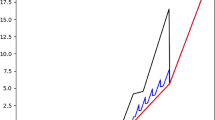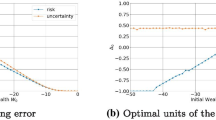Abstract
In this article we study the price of an American style option based on hedging the underlying assets in discrete time. Like its European style analog, the value of the option is not given in general by an expectation with respect to an equivalent martingale measure. We provide the optimal solution that minimizes the hedging error variance. When the assets dynamics are Markovian or a component of a Markov process, the solution can be approximated easily by numerical methods already proposed for pricing American options. We proceed to a Monte Carlo experiment in which the hedging performance of the solution is evaluated. For assets returns that are either Gaussian or Variance Gamma, it is shown that the proposed solution results in lower root mean square hedging error than with traditional delta hedging.
MSC: 91G60, 91G20.
Access this chapter
Tax calculation will be finalised at checkout
Purchases are for personal use only
Similar content being viewed by others
References
Bates, D. (1996). Jumps and stochastic volatility: Exchange rate processes implicit in Deutsche mark options. Review of Financial Studies, 9:69–108.
Bates, D. (2003). Empirical option pricing: A retrospection. Journal of Econometrics, 116:387–404.
Bouchaud, J.-P. (2000). Elements for a Theory of Financial Risks. Physica A: Statistical Mechanics and its Applications, 285:18–28.
Bouchaud, J.-P. and Potters, M. (2002). Back to basics: historical option pricing revisited. Philosophical Transactions: Mathematical, Physical & Engineering Sciences, 357:2019–2028.
Broadie, M. and Glasserman, P. (2004). A stochastic mesh method for pricing high-dimensional American options. Journal of Computational Finance, 7:35–72.
Carr, P. and Wu, L. (2004). Time-changed Lévy processes and option pricing. Journal of Financial Economics, 17:113–141.
Carriere, J. (1996). Valuation of the early-exercise price for options using simulations and nonparametric regression. Insurance: Mathematics and Economics, 19:19–30.
Chan, T. (1999). Pricing contingent claims on stocks driven by Levy processes. The Annals of Applied Probability, 9:504–528.
Christoffersen, P., Jacobs, K., and Mimoumi, K. (2010). Volatility dynamics for the S&P 500: Evidence from realized volatility, daily returns and option prices. Review of Financial Studies, 23:3141–3189.
Christoffersen, P., Jacobs, K., Ornthanalai, C., and Wang, Y. (2008). Option valuation with long-run and short-run volatility components. Journal of Financial Economics, 90:272–297.
Cornalba, L., Bouchaud, J.-P., and Potters, M. (2002). Option pricing and hedging with temporal correlations. International Journal of Theoretical and Applied Finance, 5:307–320.
Del Moral, P., Rémillard, B., and Rubenthaler, S. (2006). Monte Carlo approximations of American options. Technical report, GERAD.
Del Moral, P., Rémillard, B., and Rubenthaler, S. (2011). Monte Carlo Approximations of American Options that Preserve Monotonicity and Convexity. In Carmona, R., Moral, P. D., Hu, P., and Oudjane, N., editors, American Styles Options Pricing, page In press. Springer.
Duan, J.-C. (1995). The GARCH option pricing model. Mathematical Finance, 5:13–32.
Duffie, D. (2001). Dynamic Asset Pricing Theory. Princeton University Press.
Engle, R. and Lee, G. (1999). Cointegration, causality, and forecasting: a festschrift in honor of Clive W.J. Granger, chapter A permanent and transitory component model of stock return volatility, pages 475–497. Oxford University Press, New York.
Garleanu, N., Pedersen, L. H., and Poteshman, A. M. (2009). Demand-based option pricing. Review of Financial Studies, 22:4259–4299.
Heston, S. (1993). A closed-form solution for options with stochastic volatility with application to bond and currency options. Review of Financial Studies, 6:327–343.
Heston, S. and Nandi, S. (2000). A closed-form GARCH option pricing model. Review of Financial Studies, 13:585–626.
Huang, J.-Z. and Wu, L. (2004). Specification analysis of option pricing models based on time-changed Lvy processes. Journal of Finance, 59:1405–1439.
Hull, J. and White, A. (1987). The pricing of options on assets with stochastic volatilities. The Journal of Finance, 42:281–300.
Longstaff, F. and Schwartz, E. (2001). Valuing American options by simulation: A simple least-square approach. The Review of Financial Studies, 14:113–147.
Madan, D. B., Carr, P., and Chang, E. C. (1998). The variance gamma process and option pricing.
Merton, R. C. (1976). Option pricing when underlying stock returns are discontinuous. Journal of Financial Economics, 3:125–144.
Naik, V. (1993). Option valuation and hedging strategies with jumps in the volatility of asset returns. Journal of Finance, 48:1969–1984.
Papageorgiou, N., Rémillard, B., and Hocquard, A. (2008). Replicating the properties of hedge fund returns. Journal of Alternative Invesments, 11:8–38.
Pochart, B. and Bouchaud, J.-P. (2004). Option pricing and hedging with minimum local expected shortfall. Quantitative Finance, 4:607–618.
Rémillard, B., Hocquard, A., and Papageorgiou, N. A. (2010). Option pricing and dynamic discrete time hedging for regime-switching geometric random walks models. Technical report, HEC Montreal.
Rémillard, B. and Rubenthaler, S. (2009). Optimal hedging in discrete and continuous time. Technical report, GERAD.
Schweizer, M. (1995). Variance-optimal hedging in discrete time. Mathematics of Operations Research, 20:1–32.
Tsitsiklis, J. and Roy, B. V. (1999). Optimal stopping of Markov processes: Hilbert space theory, approximation algorithms, and an application to pricing high-dimensional financial derivatives. IEEE Transactions on Automatic Control, 44:1840–1851.
Wilmott, P. (2006). Paul Wilmott on Quantitative Finance, volume 3. John Wiley & Sons.
Author information
Authors and Affiliations
Corresponding author
Editor information
Editors and Affiliations
Rights and permissions
Copyright information
© 2012 Springer-Verlag Berlin Heidelberg
About this paper
Cite this paper
Rémillard, B., Hocquard, A., Langlois, H., Papageorgiou, N. (2012). Optimal Hedging of American Options in Discrete Time. In: Carmona, R., Del Moral, P., Hu, P., Oudjane, N. (eds) Numerical Methods in Finance. Springer Proceedings in Mathematics, vol 12. Springer, Berlin, Heidelberg. https://doi.org/10.1007/978-3-642-25746-9_5
Download citation
DOI: https://doi.org/10.1007/978-3-642-25746-9_5
Published:
Publisher Name: Springer, Berlin, Heidelberg
Print ISBN: 978-3-642-25745-2
Online ISBN: 978-3-642-25746-9
eBook Packages: Mathematics and StatisticsMathematics and Statistics (R0)




